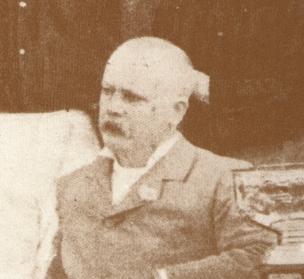A.C. Milan
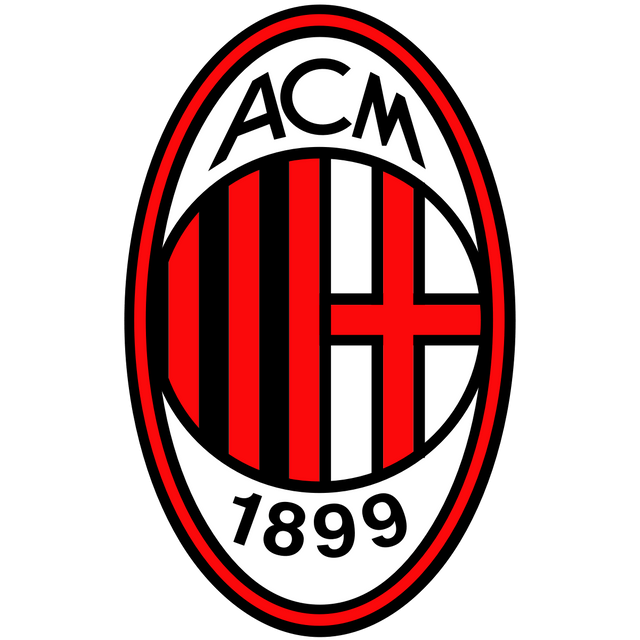
A.C. Milan

| Full name | Associazione Calcio Milan S.p.A.[3] | |||
|---|---|---|---|---|
| Nickname(s) | I Rossoneri(The Red and Blacks) Il Diavolo(The Devil) | |||
| Short name | ACM | |||
| Founded | 13 December 1899 (1899-12-13), as Milan Foot-Ball and Cricket Club | |||
| Ground | San Siro | |||
| Capacity | 80,018 | |||
| Owner | Elliot Advisors (UK) Ltd. (99.93%)[4][5] Small shareholders (0.07%)[6] | |||
| Chairman | Paolo Scaroni | |||
| Manager | Marco Giampaolo | |||
| League | Serie A | |||
| 2018–19 | Serie A, 5th | |||
| Website | Club website [166] | |||
| ||||
Associazione Calcio Milan (Italian pronunciation: [assotʃatˈtsjoːne ˈkaltʃo ˈmiːlan]), commonly referred to as A.C. Milan or simply Milan, is a professional football club in Milan, Italy, founded in 1899.[7][8] The club has spent its entire history, with the exception of the 1980–81 and 1982–83 seasons, in the top flight of Italian football, known as Serie A since 1929–30.[7]
A.C. Milan's 18 FIFA and UEFA trophies is the fourth highest out of any club (joint with Boca Juniors), and the most out of any Italian club.[9][10][11][12] Milan has won a joint record three Intercontinental Cups and one FIFA Club World Cup,[12] seven European Cup/Champions League titles (Italian record),[12] the UEFA Super Cup a joint record five times and the Cup Winners' Cup twice.[12] With 18 league titles, Milan is also the joint-second most successful club in Serie A, along with local rivals Internazionale and behind Juventus (35 league titles).[13] They have also won the Coppa Italia five times, and the Supercoppa Italiana seven.[12]
Milan's home games are played at San Siro, also known as the Stadio Giuseppe Meazza. The stadium, which is shared with city rivals Internazionale, is the largest in Italian football, with a total capacity of 80,018.[14] Inter are considered their biggest rivals, and matches between the two teams are called Derby della Madonnina, which is one of the most followed derbies in football.[15]
| Full name | Associazione Calcio Milan S.p.A.[3] | |||
|---|---|---|---|---|
| Nickname(s) | I Rossoneri(The Red and Blacks) Il Diavolo(The Devil) | |||
| Short name | ACM | |||
| Founded | 13 December 1899 (1899-12-13), as Milan Foot-Ball and Cricket Club | |||
| Ground | San Siro | |||
| Capacity | 80,018 | |||
| Owner | Elliot Advisors (UK) Ltd. (99.93%)[4][5] Small shareholders (0.07%)[6] | |||
| Chairman | Paolo Scaroni | |||
| Manager | Marco Giampaolo | |||
| League | Serie A | |||
| 2018–19 | Serie A, 5th | |||
| Website | Club website [166] | |||
| ||||
History
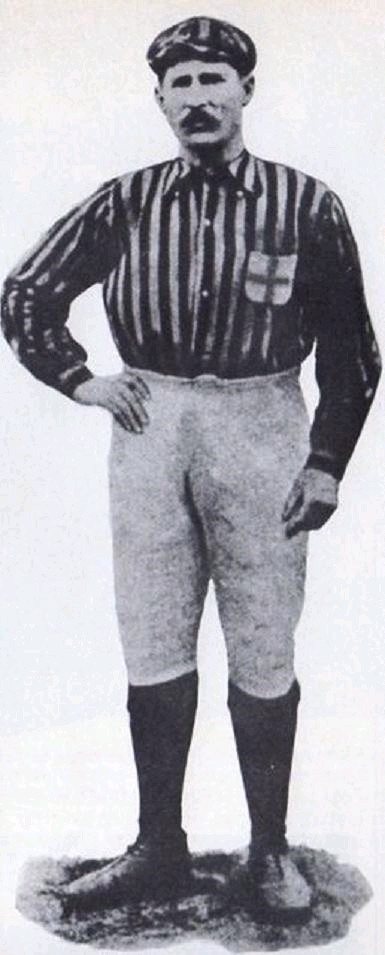
Herbert Kilpin, the club's first captain and one of its founding members
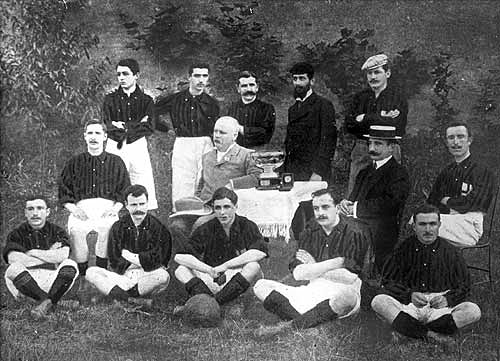
A.C. Milan in 1901
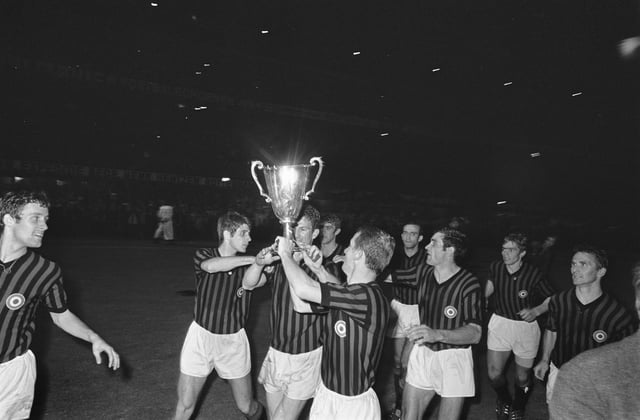
A.C. Milan celebrating after winning the European Cup Winners' Cup final in 1968
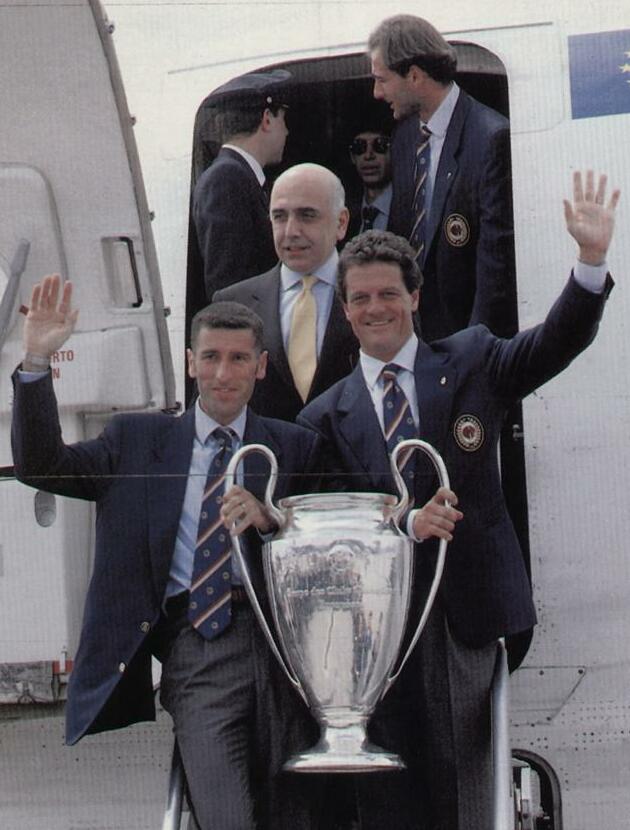
Tassotti (left) holds the UEFA Champions League trophy along with manager Fabio Capello, following Milan's victory in the 1993–94 edition of the tournament
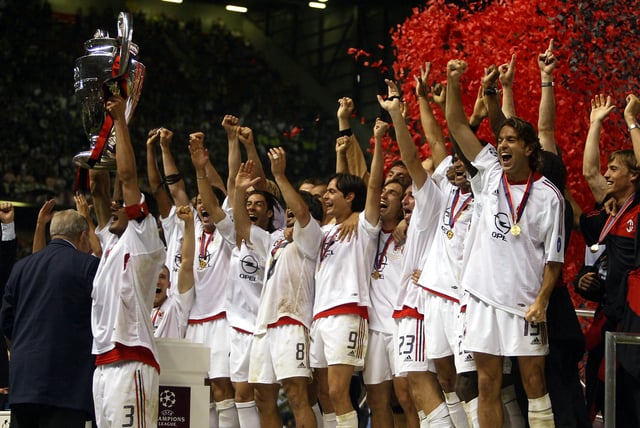
Milan captain Paolo Maldini lifting the European Cup after they won the 2002–03 UEFA Champions League
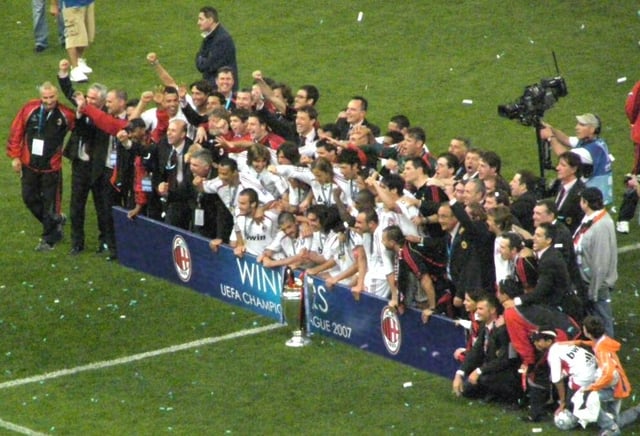
Milan celebrates winning the Champions League of season 2006–07
Saremo una squadra di diavoli. I nostri colori saranno il rosso come il fuoco e il nero come la paura che incuteremo agli avversari. | We will be a team of devils. Our colours will be red like fire and black like the fear we will invoke in our opponents. |
A.C. Milan was founded as Milan Foot-Ball and Cricket Club in 1899 by English expatriates Alfred Edwards and Herbert Kilpin.[8] Although the club itself claims 16 December of that year as its foundation date, historical evidence show that the club was actually founded on 13 December.[20] In honour of its English origins, the club has retained the English spelling of the city's name, as opposed to the Italian spelling Milano, which it was forced to bear under the fascist regime. Milan won its first Italian championship in 1901 and a further two in succession in 1906 and 1907.[7]
In 1908, Milan experienced a split caused by internal disagreements over the signing of foreign players, which led to the forming of another Milan-based team, F.C. Internazionale Milano.[21] Following these events, Milan did not manage to win a single domestic title until 1950–51.[12] The 1950s saw the club return to the top of Italian football, headed by the famous Gre-No-Li Swedish trio Gunnar Gren, Gunnar Nordahl and Nils Liedholm. This was one of the club's most successful periods domestically, with the Scudetto going to Milan in 1951, 1955, 1957, 1959 and 1962.[12] In 1963, Milan won its first continental title by beating Benfica in the final of the European Cup.[22][23] This success was repeated in 1969, with a 4–1 win over Ajax in the final, which was followed by the Intercontinental Cup title the same year.[12] During this period Milan also won its first Coppa Italia, with victory over Padova in the 1967 final, and two European Cup Winners' Cups: in 1967–68 and 1972–73.[12]
Milan won a tenth league title in 1979, but after the retirement of Gianni Rivera in the same year, the team went into a period of decline. The club was involved in the 1980 Totonero scandal and as punishment was relegated to Serie B for the first time in its history.[24] The scandal was centred around a betting syndicate paying players and officials to fix the outcome of matches.[24] Milan achieved promotion back to Serie A at the first attempt, winning the 1980–81 Serie B title,[12] but were again relegated a year later as the team ended its 1981–82 campaign in third-last place. In 1983, Milan won the Serie B title for the second time in three seasons to return to Serie A,[12] where they achieved a sixth-place finish in 1983–84.
On 20 February 1986, entrepreneur Silvio Berlusconi (who owns Fininvest and Mediaset) acquired the club and saved it from bankruptcy after investing vast amounts of money,[7] appointing rising manager Arrigo Sacchi at the helm of the Rossoneri and signing Dutch internationals Ruud Gullit, Marco van Basten and Frank Rijkaard.[7] The Dutch trio added an attacking impetus to the team, and complemented the club's Italian internationals Paolo Maldini, Franco Baresi, Alessandro Costacurta and Roberto Donadoni. Under Sacchi, Milan won its first Scudetto in nine years in the 1987–88 season. The following year, the club won its first European Cup in two decades, beating Romanian club Steaua București 4–0 in the final. Milan retained their title with a 1–0 win over Benfica a year later and was the last team to win back-to-back European Cups until Real Madrid's win in 2017.[25] The Milan team of 1989–90, nicknamed the "Immortals" in the Italian media,[26] has been voted the best club side of all time in a global poll of experts conducted by World Soccer magazine.[27]
After Sacchi left Milan in 1991, he was replaced by the club's former player Fabio Capello whose team won three consecutive Serie A titles between 1992 and 1994, a spell which included a 58-match unbeaten run in Serie A (which earned the team the label "the Invincibles"),[26][28][29] and back-to-back UEFA Champions League final appearances in 1993, 1994 and 1995. A year after losing 1–0 to Marseille in the 1993 Champions League final, Capello's team reached its peak in one of Milan's most memorable matches of all time, the famous 4–0 win over Barcelona in the 1994 Champions League final.[28] Capello's side went on to win the 1995–96 league title before he left to manage Real Madrid in 1996.[28] In 1998–99, after a two-year period of decline, Milan lifted its 16th championship in the club's centenary season.
Milan's next period of success came under another former player, Carlo Ancelotti. After his appointment in November 2001, Ancelotti took Milan to the 2003 Champions League final, where they defeated Juventus on penalties to win the club's sixth European Cup.[30] The team then won the Scudetto in 2003–04 before reaching the 2005 Champions League final, where they were beaten by Liverpool on penalties despite leading 3–0 at half-time.[30] Two years later, the two teams met again in the 2007 Champions League final, with Milan winning 2–1 to lift the title for a seventh time.[30][31] The team then won its first FIFA Club World Cup in December 2007.[32] In 2009, after becoming Milan's second longest serving manager with 420 matches overseen,[32] Ancelotti left the club to take over as manager at Chelsea.
During this period, the club was involved in the Calciopoli scandal, where five teams were accused of fixing matches by selecting favourable referees.[33] A police inquiry excluded any involvement of Milan managers,[34] but the Italian Football Federation (FIGC) unilaterally decided that it had sufficient evidence to charge Milan vice-president Adriano Galliani. As a result, Milan was initially punished with a 15-point deduction and was banned from the 2006–07 UEFA Champions League. An appeal saw that penalty reduced to eight points,[35] which allowed the club to retain its Champions League participation.
Following the aftermath of Calciopoli, local rivals Internazionale dominated Serie A, winning four Scudetti. However, with the help a strong squad boasting players such as Zlatan Ibrahimović, Robinho and Alexandre Pato joining many of the veterans of the club's mid-decade European successes, Milan recaptured the Scudetto in the 2010–11 Serie A season, their first since the 2003–04 season, and 18th overall.[36][37]
However, after the Scudetto the club declined in performance. It saw the club fail to qualify to European competitions for a few years. Fininvest, the holding company of the club also signed a preliminary agreement with Bee Taechaubol to sell 48% stake of the club for €480 million in 2015,[38] after a net loss of €91.3 million in 2014 financial year and subsequent financial contribution from Fininvest.[39] However, the deal collapsed. On 5 August 2016, a new preliminary agreement was signed with a Chinese investment management company Sino-Europe Sports Investment Management Changxing Co., which Fininvest sold 99.93% stake of Milan for about €520 million, plus the refurbishment of the club financial debt of €220 million.[40] On 13 April 2017, the deal was completed and Rossoneri Sport Investment Lux became the new direct parent company of the club.[41] In order to finalize the deal, American hedge fund Elliott Management Corporation provided Li with a loan of €303M (€180M to complete the payment to Finivest and €123M issued directly to the club).[42][43] On 10 July 2018, Li failed to keep up with his loan repayment plan, neglecting to deposit a €32-million installment on time in order to refinance the €303-million loan debt owed to the American hedge fund. As a result, In July 2018, chairman Li Yonghong's investment vehicle Rossoneri Champion Inv. Lux. was removed as the shareholder of Rossoneri Sport Inv. Lux., the direct parent company of the club, making the investment vehicle majority controlled by Elliott Management Corporation the sole shareholder of Rossoneri Sport Inv. Lux.[44][45][46][47]
Milan qualified for the 2018–19 UEFA Europa League group stage as the sixth-placed team of the 2017–18 Serie A, but were originally banned by UEFA from European competition due to violations of Financial Fair Play regulations for failure to break-even.[48] Milan appealed to the Court of Arbitration for Sport and was partially accepted on 20 July 2018; the court ordered UEFA to issue a proportionate disciplinary measure other than ban.[49][50] On 28 June 2019 Milan have been excluded from the 2019-20 UEFA Europa League as a result of Financial Fair Play breaches.[51][52]
Colours and badge

The coat of arms of the city of Milan was the club badge of the first decades.
Red and black are the colours which have represented the club throughout its entire history. They were chosen to represent the players' fiery ardor (red) and the opponents' fear to challenge the team (black). Rossoneri, the team's widely used nickname, literally means "the red & blacks" in Italian, in reference to the colours of the stripes on its jersey.[53]
Another nickname derived from the club's colours is the Devil. An image of a red devil was used as Milan's logo at one point with a Golden Star for Sport Excellence located next to it.[54] As is customary in Italian football, the star above the logo was awarded to the club after winning 10 league titles, in 1979. For many years, Milan's badge was simply the Flag of Milan, which was originally the flag of Saint Ambrose.[54] The modern badge used today represents the club colours and the flag of the Comune di Milano, with the acronym ACM at the top and the foundation year (1899) at the bottom.[54]
White shorts and black socks are usually worn as part of the home strip. Milan's away strip has always been completely white.[55] It is considered by both the fans and the club to be a lucky strip in Champions League finals, due to the fact that Milan has won six finals out of eight in an all white strip (losing only to Ajax in 1995 and Liverpool in 2005), and only won one out of three in the home strip. The third strip, which is rarely used, changes yearly, being mostly black with red trimmings in recent seasons.
I can't think of many shirts out there that are as recognisable as Milan's. – Our kits go beyond just the sphere of football. |
Kit suppliers and shirt sponsors
| Period | Kit manufacturer | Shirt sponsor | |
|---|---|---|---|
| Brand | Company | ||
| 1981–82 | Linea Milan | Pooh Jeans | Italiana Manifatture |
| 1982–83 | NR | Hitachi | Hitachi Europe |
| 1983–84 | Cuore | ||
| 1984–85 | Rolly Go | Oscar Mondadori | Arnoldo Mondadori Editore |
| 1985–86 | Gianni Rivera | Fotorex U-Bix | Olivetti |
| 1986–87 | Kappa | ||
| 1987–90 | Mediolanum | ||
| 1990–92 | Adidas | ||
| 1992–93 | Motta | ||
| 1993–94 | Lotto | ||
| 1994–98 | Opel | General Motors | |
| 1998–06 | Adidas | ||
| 2006–10 | Bwin | ||
| 2010–18 | Emirates | The Emirates Group | |
| 2018– | Puma[57][58] | ||
Kit deals
| Kit supplier | Period | Contract announcement | Contract duration | Value | Notes |
|---|---|---|---|---|---|
Adidas | 1998–2018 | ||||
2013–10-09 | 2013–2018 (5 years) | €20 million per year[59] | Original contract duration: 2013–2023 But contract was prematurely terminated by mutual consent at the end of the 2017–2018 season.[60] | ||
Puma | 2018–present | 2018–02-12 | 2018–unknown (? years) | Between €10 million and 15 million per year[61] |
Stadium

View of the San Siro in 1934.
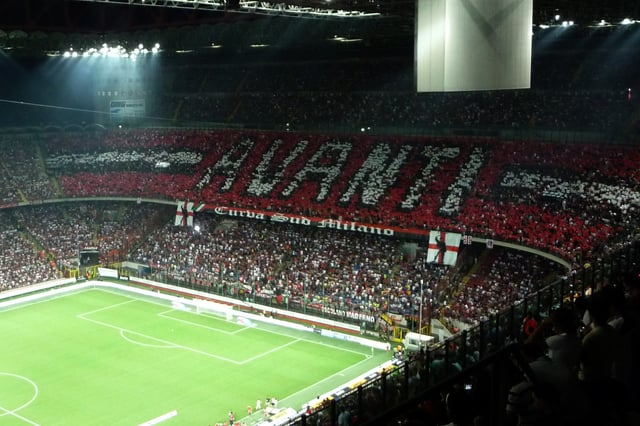
Curva Sud of the San Siro.
The team's stadium is the 80,018 seat San Siro, officially known as Stadio Giuseppe Meazza after the former player who represented both Milan and Internazionale. The more commonly used name, "San Siro", is the name of the district where it is located. San Siro has been the home of Milan since 1926, when it was privately built by funding from Milan's president at the time, Piero Pirelli. Construction was performed by 120 workers, and took 13-and-a-half months to complete. The stadium was owned by the club until it was sold to the city in 1935, and since 1947, it has been shared with Internazionale when the other major Milanese club was accepted as joint tenant.
The first game played at the stadium was on 19 September 1926, when Milan lost 6–3 in a friendly match against Internazionale. Milan played its first league game in San Siro on 19 September 1926, losing 1–2 to Sampierdarenese. From an initial capacity of 35,000 spectators, the stadium has undergone several major renovations, most recently in preparation for the 1990 FIFA World Cup when its capacity was set to 85,700, all covered with a polycarbonate roof. In the summer of 2008 its capacity has been reduced to 80,018, to meet the new standards set by UEFA.
Based on the English model for stadiums, San Siro is specifically designed for football matches, as opposed to many multi-purpose stadiums used in Serie A. It is therefore renowned in Italy for its fantastic atmosphere during matches, largely thanks to the closeness of the stands to the pitch. The frequent use of flares by supporters contributes to the atmosphere but the practice has occasionally caused problems.
On 19 December 2005, Milan vice-president and executive director Adriano Galliani announced that the club was seriously working towards a relocation. He stated Milan's new stadium will be largely based on the Veltins-Arena – the home of Schalke 04 in Gelsenkirchen – and will follow the standards of football stadiums in the United States, Germany and Spain. As opposed to many other stadiums in Italy, Milan's new stadium would likely be used for football only, having no athletics track. On 11 December 2014, Barbara Berlusconi announced a proposal to build a property stadium of 42,000 seats in Portello, behind the new HQ of the Rossoneri, and the large square "Piazza Gino Valle". The new village with shopping malls and hotel is located near CityLife district and is served by the metro.[62] On 20 September 2015, however, Silvio Berlusconi called an end to his club's plans to build a new stadium in the city.[63] In 2017, new CEO Marco Fassone stated that the club may look at either staying in the San Siro or moving to a new stadium with the club hierarchy emphasizing the need to increase average attendance for home games.[64]
Supporters and rivalries
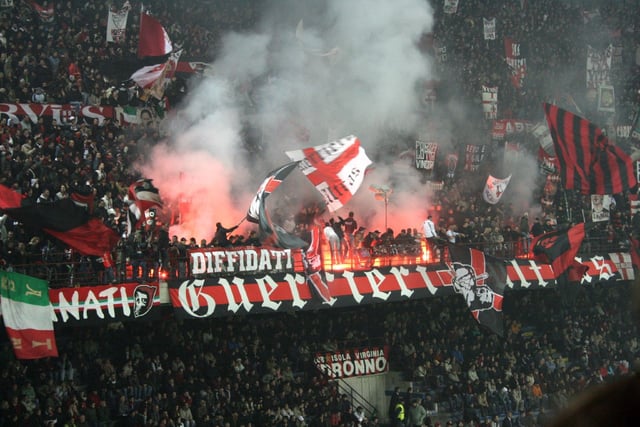
Brigate Rossonere
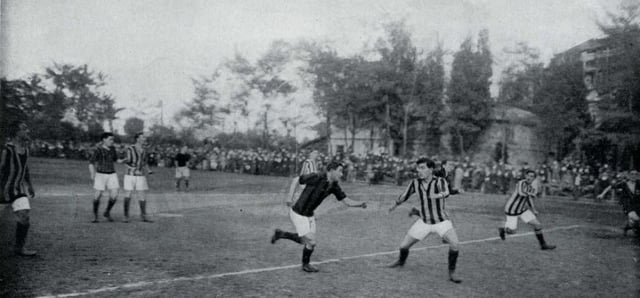
Scene of a Derby della Madonnina in 1915.

Brothers Giuseppe (left) and Franco (right) Baresi facing each other in the 1979–80 Milan derby
Milan is one of the best supported football clubs in Italy, according to research conducted by Italian newspaper La Repubblica.[65] Historically, Milan was supported by the city's working-class.[66] On the other hand, crosstown rivals Internazionale were mainly supported by the more prosperous middle-class.[66] The oldest ultras groups in all of Italian football, Fossa dei Leoni, originated in Milan.[67] Currently, the main ultras group within the support base is Brigate Rossonere.[67] Politically, Milan ultras have never had any particular preference,[67] but the media traditionally associated them with the left-wing,[68] until recently, when Berlusconi's presidency somewhat altered that view.[69]
According to a study from 2010, Milan is the most supported Italian team in Europe and seventh overall, with over 18.4 million fans.[70] It had the ninth highest average attendance of European football clubs during the 2010–11 season, behind Borussia Dortmund, Barcelona, Manchester United, Real Madrid, Bayern Munich, Schalke 04, Arsenal and Hamburger SV.[71][72][73][74][75]
Genoa fans consider Milan a hated rival after Genoa fan Vincenzo Spagnolo was stabbed to death by a Milan supporter in January 1995.[76] Milan's main rivalry, however, is with its neighbour club, Internazionale, where both clubs meet in the widely anticipated Derby della Madonnina twice every Serie A season. The name of the derby refers to the Blessed Virgin Mary, whose statue atop the Milan Cathedral is one of the city's main attractions. The match usually creates a lively atmosphere, with numerous (often humorous or offensive) banners unfolded before the start of the game. Flares are commonly present and contribute to the spectacle but they have occasionally led to problems, including the abandonment of the second leg of the 2004–05 Champions League quarter-final match between Milan and Inter on 12 April 2005, after a flare thrown from the crowd by an Inter supporter struck Milan goalkeeper Dida on the shoulder.[77]
The rivalry with Juventus F.C. is a rivalry between the two most titled teams in Italy. The challenge confronts also two of the clubs with greater basin of supporters as well as those with the greatest turnover and stock market value in the country.[78] The match-ups between Milan and Juventus, is regarded as the championship of Serie A, and both teams were often fighting for the top positions of the standings, sometimes even decisive for the award of the title.[79] Milan also have rivalries with Roma and Fiorentina.
Honours
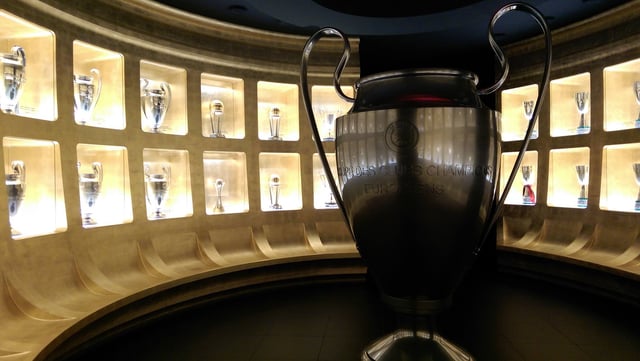
A partial view of the club's trophy room at the Mondo Milan Museum
Milan is one of the most successful clubs in Italy, having won a total of 30 domestic honours, in addition to their continental successes. Milan has earned the right to place a star on its jersey in recognition of the fact that it has won at least ten scudetti. In addition, the club is permanently allowed to display a multiple-winner badge on its shirt as it has won more than five European Cups.[80]
| Type | Competition | Titles | Seasons |
|---|---|---|---|
| Domestic | Serie A | 18 | 1901, 1906, 1907, 1950–51, 1954–55, 1956–57, 1958–59, 1961–62, 1967–68, 1978–79, 1987–88, 1991–92, 1992–93, 1993–94, 1995–96, 1998–99, 2003–04, 2010–11 |
| Serie B | 2 | 1980–81, 1982–83 | |
| Coppa Italia | 5 | 1966–67, 1971–72, 1972–73, 1976–77, 2002–03 | |
| Supercoppa Italiana | 7 | 1988, 1992, 1993, 1994, 2004, 2011, 2016 | |
| Continent | European Cup / UEFA Champions League | 7 | 1962–63, 1968–69, 1988–89, 1989–90, 1993–94, 2002–03, 2006–07 |
| UEFA Cup Winners' Cup | 2 | 1967–68, 1972–73 | |
| European Super Cup / UEFA Super Cup | 5s | 1989, 1990, 1994, 2003, 2007 | |
| Worldwide | Intercontinental Cup | 3s | 1969, 1989, 1990 |
| FIFA Club World Cup | 1 | 2007 |
record
s shared record
Club statistics and records
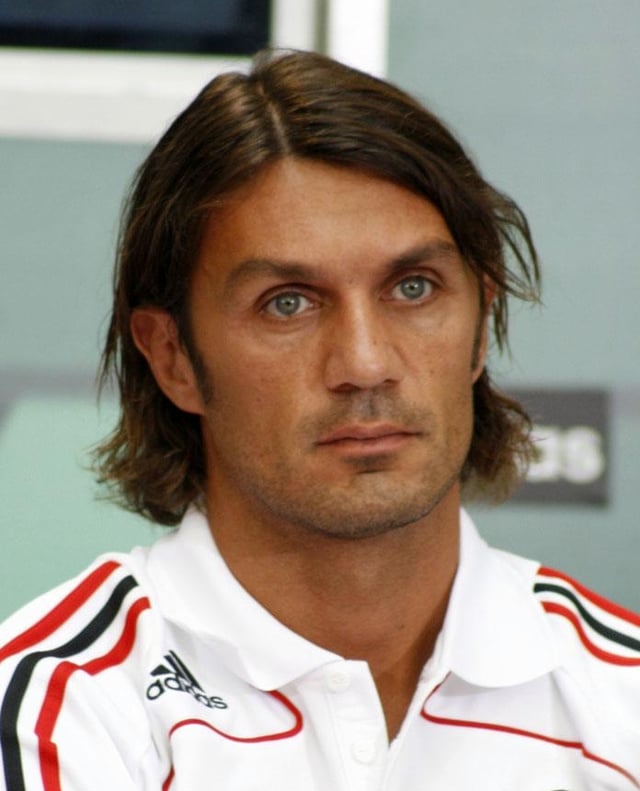
Paolo Maldini made a record 902 appearances for Milan, including 647 in Serie A.
Swedish forward Gunnar Nordahl scored 38 goals in the 1950–51 season, 35 of which were in Serie A, setting an Italian football and club record. He went on to become Milan's all-time top goalscorer, scoring 221 goals for the club in 268 games.[83] He is followed in second place by Andriy Shevchenko with 175 goals in 322 games, and Gianni Rivera in third place, who has scored 164 goals in 658 games. Rivera is also Milan's youngest ever goalscorer, scoring in a league match against Juventus at just 17 years.
Legendary tactician Nereo Rocco, the first proponent of catenaccio in the country, was Milan's longest-serving manager, sitting on the bench for over nine years (in two spells) in the 1960s and early 1970s, winning the club's first European Cup triumphs. Italian Prime Minister Silvio Berlusconi, who purchased the club in 1986, is Milan's longest-serving president (23 years, due to a two-year vacancy between 2004 and 2006).
The first official match in which Milan participated was in the Third Federal Football Championship, the predecessor of Serie A, losing 3–0 to Torinese. Milan's largest ever victory was 13–0 against Audax Modena, in a league match at the 1914–15 season. Its heaviest defeat was recorded in the league at the 1922–23 season, beaten 0–8 by Bologna.
During the 1991–92 season, the club achieved the feature of being the first team to win the Serie A title without losing a single game. Previously, only Perugia had managed to go unbeaten over an entire Serie A season (1978–79), but finished second in the table. In total, Milan's unbeaten streak lasted 58 games, starting with a 0–0 draw against Parma on 26 May 1991 and coincidentally ending with a 1–0 home loss to Parma on 21 March 1993. This is a Serie A record as well as the third-longest unbeaten run in top flight European football, coming in behind Steaua București's record of 104 unbeaten games and Celtic's 68 game unbeaten run.[84][85]
The sale of Kaká to Real Madrid in 2009 broke the eight-year-old world football transfer record held by Zinedine Zidane, costing the Spanish club €67 million[88] (about £56 million[89]). That record, however, lasted for less than a month, broken by Cristiano Ronaldo's £80 million transfer.[90] This record, however, is in terms of nominal British pound rates, not adjusted to inflation or the real value of the euro. Madrid bought Zidane for €77.5 million in 2001,[91][92] about £46 million at that time.
Players
First team squad
- As of 2 September 2019.[93]
Note: Flags indicate national team as defined under FIFA eligibility rules. Players may hold more than one non-FIFA nationality.
|
|
For recent transfers, see 2019–20 A.C. Milan season.
Out on loan
Note: Flags indicate national team as defined under FIFA eligibility rules. Players may hold more than one non-FIFA nationality.
|
|
Youth teams
Milan Women
Former players
Club captains
Player records
Retired numbers
- Might be restored for one of his two sons, should either of them play professionally for the club.
Coaching staff
| Position | Name |
|---|---|
| Manager | Marco Giampaolo |
| Assistant manager | Francesco Conti |
| Assistants | Daniele Bonera |
| Salvatore Foti | |
| Fabio Micarelli | |
| Fitness coaches | Samuele Melotto |
| Stefano Rapetti | |
| Goalkeeping coach | Luigi Turci |
| Assistant goalkeeping coach | Emiliano Betti |
Chairmen and managers
Chairmen history
Managerial history
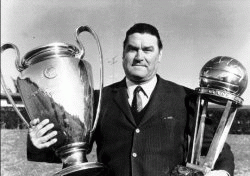
Nereo Rocco, the most successful manager in the history of A.C. Milan with 10 trophies
Below is a list of Milan managers from 1900 until the present day.[115]
A.C. Milan as a company
On 13 April 2017 Milan became a subsidiary of Rossoneri Sport Investment Luxembourg, which acquired 99.92973% shares of A.C. Milan S.p.A. from Fininvest. Li Yonghong became the new chairman[1] and Marco Fassone was confirmed as CEO. The other members of the board of directors were Roberto Cappelli, David Han Li, Lu Bo (Chinese: 路博 of Haixia Capital[116]), Marco Patuano, Paolo Scaroni and Xu Renshuo.[117] (Chinese: 许仁硕)[116] However, Li Yonghong's investment vehicle was removed as the shareholder of Rossoneri Sport Investment Luxembourg on 10 July after defaulted in a pledge to Elliott Management Corporation, which lent a large sum of money to Li in 2017 to finalize the acquisition.[118][119] Other partners of Elliott were Arena Investors[119] and Blue Skye, according to news reports.[120]
According to The Football Money League published by consultants Deloitte, in the 2005–06 season, Milan was the fifth-highest earning football club in the world with an estimated revenue of €233.7 million.[122] However, it fell to eighth in 2011–12 season,[123] tenth in 2012–13 and twelfth in 2013–14 season. The club is also ranked as the eighth-wealthiest football club in the world by Forbes magazine as of 2014, making it the wealthiest in Italian football, just surpassing ninth-ranked Juventus by a narrow margin.[16]
Previously, German car manufacturer Opel (owned by General Motors) had sponsored Milan for 12 seasons.[126] For most of those 12 years, "Opel" was displayed on the front of the shirt, but in the 2003–04 and the 2005–06 seasons respectively, "Meriva" and "Zafira" (two cars from the company's range) were displayed.
The current shirts are supplied by Puma. Previously it was supplied by German sportswear manufacturer Adidas, whose deal was scheduled to run until 2023.[127] The deal made Adidas the official manufacturer of all kits, training equipment and replica outfits. However, an early termination of the deal was announced in October 2017,[128] effective on 30 June 2018. Prior to Adidas, the Italian sports company Lotto produced Milan's sportswear.
A.C. Milan Group made an aggregate net loss in recent years, which was one of the largest among the Italian clubs, notably: 2005, net loss of €4.5 million (separate account);[129] 2006, a net income of €11.9 million[129] (mainly contributed by the sales of Andriy Shevchenko);[130] 2007, a net loss of €32 million;[131] 2008, a net loss of €77 million;[132] 2009, a net loss of €19 million[88] (the decreased net loss was mainly contributed by the sales of Kaká);[133] 2010, a net loss of €65 million;[134] in 2011, a net loss of €67.334 million,[135] in 2012, a net loss of €6.857 million[136] (contributed by the sales of Thiago Silva and Zlatan Ibrahimović).[137] and in 2013, a net loss of €15.7 million[138] (with some contribution by the sales of Kevin-Prince Boateng and Alexandre Pato[139][137] and other players, as well as decrease in wage bill.[140])
As a consequence of the aggregate 2.5-year financial result in the reporting periods ending at 31 December 2015, 31 December 2016 and 30 June 2017 (a FFP-adjusted net loss of €146 million, €121 million in excess of the acceptable deviation in the regulation[141] [] ), Milan was initially banned from European competitions due to breach in UEFA Financial Fair Play Regulations. However, the European ban was lifted by an appeal to the Court of Arbitration for Sport.[141] Milan was allowed to achieve the break even condition on or before 30 June 2021.[142]
| Year | Revenue | Profit | Total Assets | Equity | Re-capitalization |
|---|---|---|---|---|---|
| 2006[143] | 00305.111 | 000011.904 | 00287.065 | ||
| 2007[144] | |||||
| 2008[132][145] | |||||
| 2009[146] (restated)[134] | |||||
| 2010[134][147] | |||||
| 2011[148] | |||||
| 2012[136] | |||||
| 2013[138] | |||||
| 2014[39][149] | |||||
| 2015 (restated)[150] | |||||
| 2016[151] | |||||
| 2017 (first half)[152][153][154] | |||||
| 2017–18 | |||||
| 2018–19 |
Note: Re-capitalization figures were obtained from item versamenti soci in conto capitale e/o copertura perdite, for 2006 to 2017 financial year
Superleague Formula
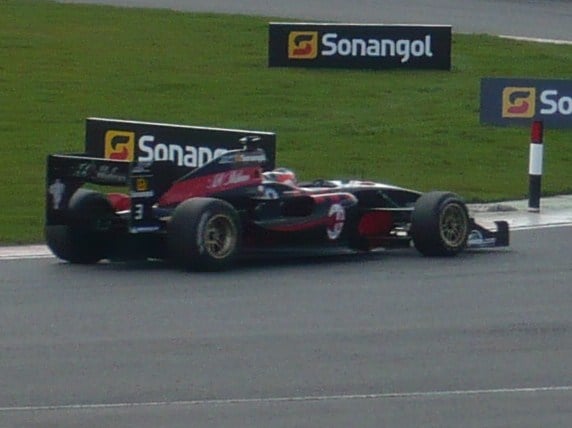
A.C. Milan Superleague Formula car
Milan had a team in the Superleague Formula race car series where teams are sponsored by football clubs. Robert Doornbos, formerly driving for Minardi and Red Bull Racing in the Formula One World Championship, drove for Milan in 2008.[160] Doornbos won his first race for the team at Nürburgring, Germany. Giorgio Pantano is driving for Milan in the 2009 season and he has also won races for the team.[161] The team folded in 2010 along with the series in 2011.
See also
Dynasties in Italian football


